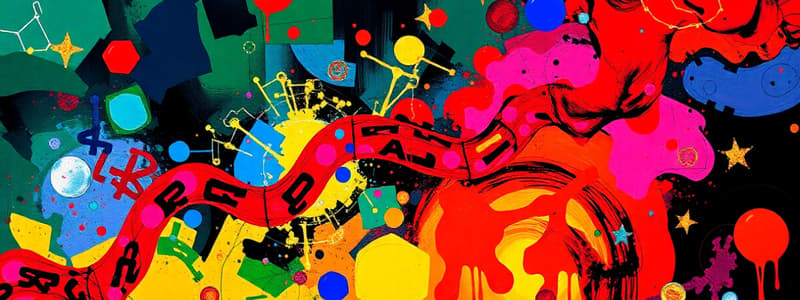Podcast
Questions and Answers
What types of residues can act as nucleophiles?
What types of residues can act as nucleophiles?
- Unprotonated His imidazole
- Unprotonated α-amino group
- Unprotonated thiol of Cys
- All of the above (correct)
Which of the following is a strategy used in catalysis?
Which of the following is a strategy used in catalysis?
- Covalent Catalysis
- General Acid-Base Catalysis
- Catalysis by Approximation
- All of the above (correct)
What is the role of metal ions in enzymatic reactions?
What is the role of metal ions in enzymatic reactions?
Metal ions can facilitate the formation of a nucleophile, serve as an electrophile, or act as a bridge between the enzyme and substrate.
What enzyme cleaves peptide bonds after bulky, aromatic residues?
What enzyme cleaves peptide bonds after bulky, aromatic residues?
Chymotrypsin catalyzes reactions using ______ catalysis and general base catalysis.
Chymotrypsin catalyzes reactions using ______ catalysis and general base catalysis.
Chymotrypsin hydrolyzes ATP.
Chymotrypsin hydrolyzes ATP.
What makes a good nucleophile?
What makes a good nucleophile?
Match the enzyme with its function:
Match the enzyme with its function:
What are the catalytic triad residues of chymotrypsin?
What are the catalytic triad residues of chymotrypsin?
Flashcards are hidden until you start studying
Study Notes
Enzymatic Challenges
- Enzymes increase the rate of slow reactions.
- They help achieve rapid reaction rates for physiological processes integration.
- They ensure high reaction specificity.
- They utilize ATP hydrolysis energy to drive other processes.
Catalytic Strategies
-
Covalent Catalysis: Enzymes contain a reactive group (nucleophile) that temporarily binds to the substrate. Potential nucleophiles include unprotonated histidine imidazole, amino groups, thiolates, and the R groups of serine, glutamate, and aspartate.
-
General Acid-Base Catalysis: Molecules, other than water, act as proton donors (acids) or acceptors (bases). The group that donates a proton must later accept a proton to regenerate the enzyme. Potential residues include histidine imidazole, amino groups, cysteine thiol, glutamate, aspartate, lysine, tyrosine, and arginine.
-
Catalysis by Approximation: Enzymes catalyze reactions between two substrates by bringing them together in their active site. This decreases the entropy of the system and speeds up the reaction.
-
Metal Ion Catalysis: Metal ions can play various roles in catalysis, including stabilizing negative charges on intermediates, facilitating nucleophile formation, and acting as bridges between the enzyme and substrate.
Enzyme Mechanisms
- Chymotrypsin: A digestive enzyme synthesized in the pancreas. It cleaves peptide bonds after bulky aromatic residues like phenylalanine, tyrosine, and tryptophan.
- Carbonic Anhydrase: Adds water to carbon dioxide.
- Restriction Endonuclease (EcoRV): Hydrolyzes DNA at specific sites.
- Myosin: Hydrolyzes ATP.
What Makes a Good Nucleophile?
- A good nucleophile wants to donate electrons (Lewis base).
- A good nucleophile is polarizable (larger) and not sterically hindered.
- A good nucleophile is not in a highly polar solvent.
Chymotrypsin
- It's a digestive enzyme synthesized in the pancreas.
- It is involved in protein turnover.
- It cleaves peptide bonds after bulky, aromatic residues.
- It speeds up a slow reaction by making the carbonyl group more susceptible to nucleophilic attack by water.
- It uses covalent catalysis (assisted by general base catalysis).
Chymotrypsin Mechanism
- Acylation Phase: The first substrate (protein/peptide) binds. The serine nucleophile attacks the carbonyl of the peptide bond, releasing the amine component (C-terminus of the protein).
- Deacylation Phase: The second substrate (water) binds. Water attacks the carbonyl group of the original peptide bond, releasing the carboxylic acid component (N-terminus of the protein).
Chymotrypsin Structure and Active Site
- It is spherical.
- It is composed of three polypeptide chains.
- Its active site is a cleft on the enzyme surface.
- The catalytic triad includes Ser195, His57, and Asp102.
Studying That Suits You
Use AI to generate personalized quizzes and flashcards to suit your learning preferences.




